Commercial Law: Negligence, ACL, and Defences in Australian Law Report
VerifiedAdded on 2020/06/04
|10
|3265
|78
Report
AI Summary
This report delves into the intricacies of Australian commercial law, analyzing key concepts such as negligence, duty of care, and the application of the Australian Consumer Law (ACL). The report examines various case scenarios, including incidents at sporting events and product liability cases, to illustrate the practical application of legal principles. It explores the requirements for proving negligence, potential defenses, and the rights available to parties under the ACL, particularly focusing on the liabilities of manufacturers and suppliers. The report also addresses the Occupiers Liability Act and relevant case laws like Cleghorn versus Oldham, Bolton Vs Stone, and Langham Vs Connell Point Rovers Soccer Club 2005 to provide a comprehensive understanding of commercial law principles and their implications in real-world situations. The report also examines the rights of consumers under Part 3-5 of the ACL when dealing with defective goods and the manufacturer's liabilities.
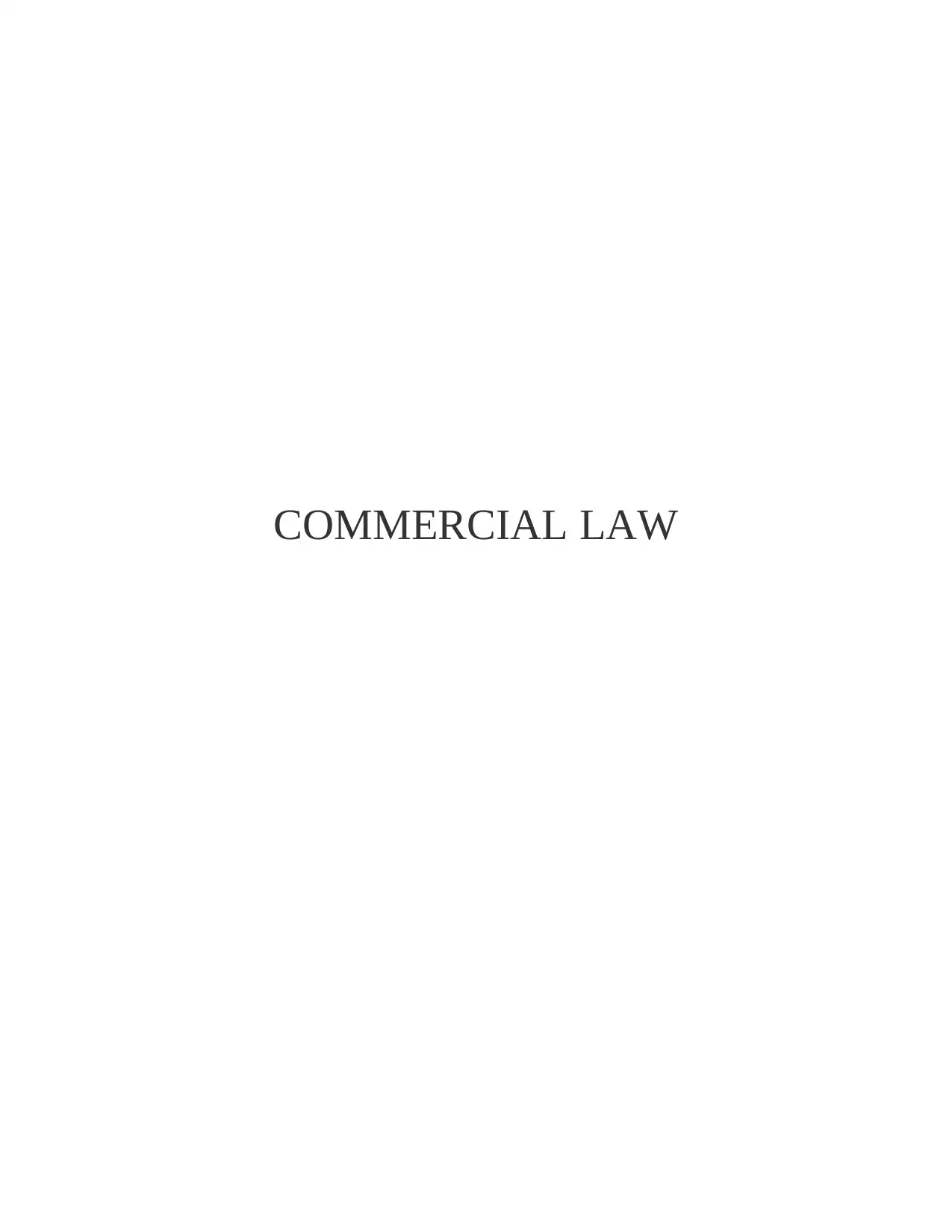
COMMERCIAL LAW
Paraphrase This Document
Need a fresh take? Get an instant paraphrase of this document with our AI Paraphraser
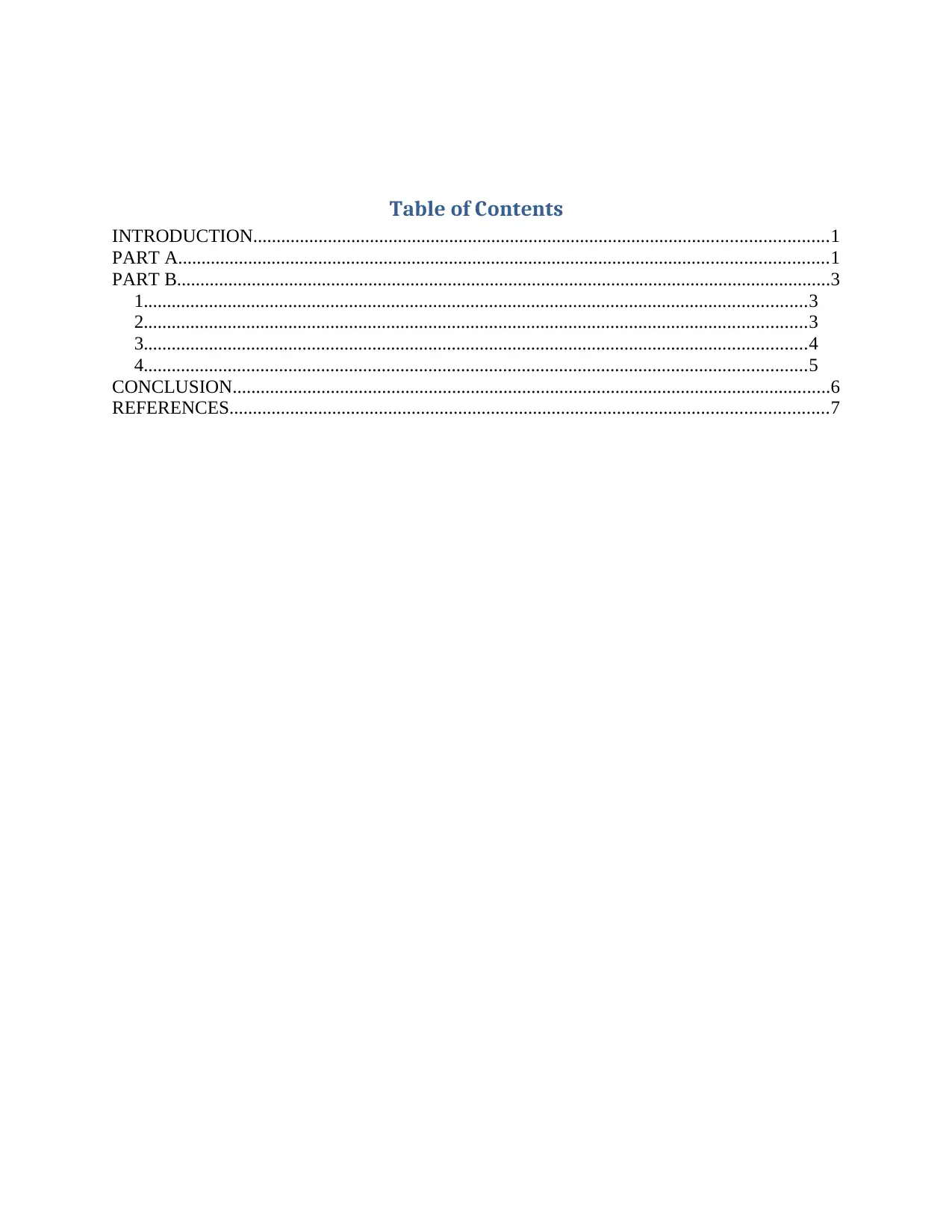
Table of Contents
INTRODUCTION...........................................................................................................................1
PART A...........................................................................................................................................1
PART B............................................................................................................................................3
1..............................................................................................................................................3
2..............................................................................................................................................3
3..............................................................................................................................................4
4..............................................................................................................................................5
CONCLUSION................................................................................................................................6
REFERENCES................................................................................................................................7
INTRODUCTION...........................................................................................................................1
PART A...........................................................................................................................................1
PART B............................................................................................................................................3
1..............................................................................................................................................3
2..............................................................................................................................................3
3..............................................................................................................................................4
4..............................................................................................................................................5
CONCLUSION................................................................................................................................6
REFERENCES................................................................................................................................7

INTRODUCTION
Commercial law of Australia make rules and regulations for all the commercial
transactions including contract, agency, insurance, banking, finance, agency, export and import
and many others. It is a system that applies rights and duties on all the activities in the field of
commerce including merchandising, trading, sales & distribution and others. The current
research key thrust is to apply principles of commercial law on the different case scenarios to
take legal actions with the proper legal evidences. Moreover, the research will investigate the
common law duty of negligence and the possible defences under it. In addition to this, Australian
Consumer Law (ACL), part 3-5 will be discussed to identify possible rights available to different
parties. Besides this, possible defences available to the goods manufacturer under section 142 of
the ACL will be discussed.
PART A
Negligence can be defined as a failure to take reasonable duty of care towards other and
its breach or violation caused damage to other. Thus, if a party who is liable to take proper care
towards other but failed to exercise the expected care is known as negligence (Ben-Shahar and
Porat, 2016). According to the case, P is a lifelong fan of ABC Football Club, when he was
watching the game, suddenly, he was struck by a stray ball had broken P’s glasses. The law of
negligence applies on sporting events or contest because many-times, during game, injuries may
be suffered by different people. As per the law, there are three most important requirements that
need to be satisfied to proven negligence act by other that is mentioned below:
Duty of care: Defendant must owe standard duty of care towards the plaintiff and as per
which, he or she is liable to take reasonable care to avoid any harm or injury.
Breach of duty: In order to claim for negligence, it is necessary that defendant failed to
exercise reasonable actions to not harm the plaintiff. Thus, violation of the duty of care is
necessary (Davis, 2012).
Damage: Breach or duty of care towards plaintiff must cause damage.
In a sporting event, all the players owe duty of care towards other competitors and
spectators too hence, they are accountable to follow reasonable care and precautions to not harm
other. While watching a sport, spectators are assumed with certain risks and such assumptions
therefore, are a possible defence against claim while watching the tournament. Referring the case
Page | 1
Commercial law of Australia make rules and regulations for all the commercial
transactions including contract, agency, insurance, banking, finance, agency, export and import
and many others. It is a system that applies rights and duties on all the activities in the field of
commerce including merchandising, trading, sales & distribution and others. The current
research key thrust is to apply principles of commercial law on the different case scenarios to
take legal actions with the proper legal evidences. Moreover, the research will investigate the
common law duty of negligence and the possible defences under it. In addition to this, Australian
Consumer Law (ACL), part 3-5 will be discussed to identify possible rights available to different
parties. Besides this, possible defences available to the goods manufacturer under section 142 of
the ACL will be discussed.
PART A
Negligence can be defined as a failure to take reasonable duty of care towards other and
its breach or violation caused damage to other. Thus, if a party who is liable to take proper care
towards other but failed to exercise the expected care is known as negligence (Ben-Shahar and
Porat, 2016). According to the case, P is a lifelong fan of ABC Football Club, when he was
watching the game, suddenly, he was struck by a stray ball had broken P’s glasses. The law of
negligence applies on sporting events or contest because many-times, during game, injuries may
be suffered by different people. As per the law, there are three most important requirements that
need to be satisfied to proven negligence act by other that is mentioned below:
Duty of care: Defendant must owe standard duty of care towards the plaintiff and as per
which, he or she is liable to take reasonable care to avoid any harm or injury.
Breach of duty: In order to claim for negligence, it is necessary that defendant failed to
exercise reasonable actions to not harm the plaintiff. Thus, violation of the duty of care is
necessary (Davis, 2012).
Damage: Breach or duty of care towards plaintiff must cause damage.
In a sporting event, all the players owe duty of care towards other competitors and
spectators too hence, they are accountable to follow reasonable care and precautions to not harm
other. While watching a sport, spectators are assumed with certain risks and such assumptions
therefore, are a possible defence against claim while watching the tournament. Referring the case
Page | 1
⊘ This is a preview!⊘
Do you want full access?
Subscribe today to unlock all pages.

Trusted by 1+ million students worldwide
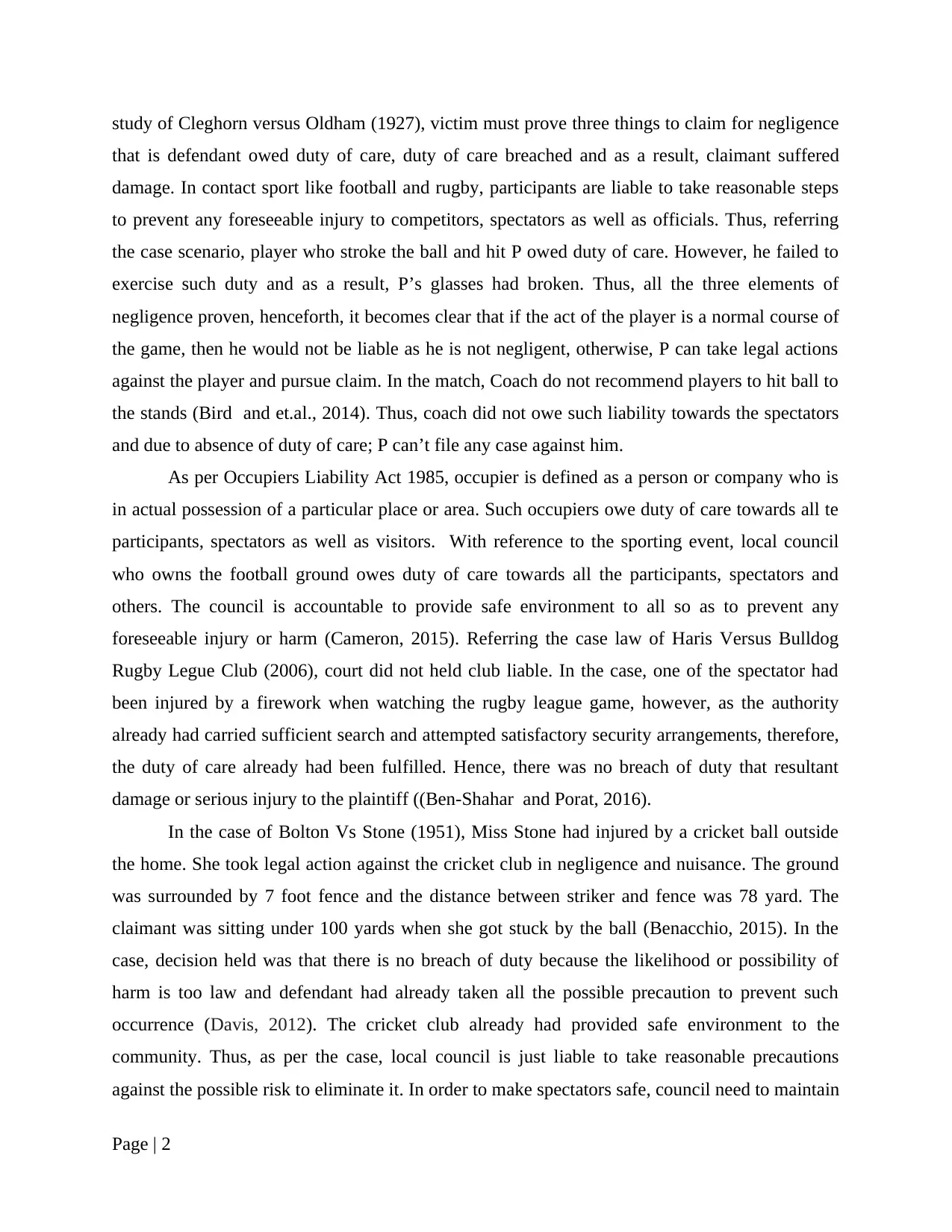
study of Cleghorn versus Oldham (1927), victim must prove three things to claim for negligence
that is defendant owed duty of care, duty of care breached and as a result, claimant suffered
damage. In contact sport like football and rugby, participants are liable to take reasonable steps
to prevent any foreseeable injury to competitors, spectators as well as officials. Thus, referring
the case scenario, player who stroke the ball and hit P owed duty of care. However, he failed to
exercise such duty and as a result, P’s glasses had broken. Thus, all the three elements of
negligence proven, henceforth, it becomes clear that if the act of the player is a normal course of
the game, then he would not be liable as he is not negligent, otherwise, P can take legal actions
against the player and pursue claim. In the match, Coach do not recommend players to hit ball to
the stands (Bird and et.al., 2014). Thus, coach did not owe such liability towards the spectators
and due to absence of duty of care; P can’t file any case against him.
As per Occupiers Liability Act 1985, occupier is defined as a person or company who is
in actual possession of a particular place or area. Such occupiers owe duty of care towards all te
participants, spectators as well as visitors. With reference to the sporting event, local council
who owns the football ground owes duty of care towards all the participants, spectators and
others. The council is accountable to provide safe environment to all so as to prevent any
foreseeable injury or harm (Cameron, 2015). Referring the case law of Haris Versus Bulldog
Rugby Legue Club (2006), court did not held club liable. In the case, one of the spectator had
been injured by a firework when watching the rugby league game, however, as the authority
already had carried sufficient search and attempted satisfactory security arrangements, therefore,
the duty of care already had been fulfilled. Hence, there was no breach of duty that resultant
damage or serious injury to the plaintiff ((Ben-Shahar and Porat, 2016).
In the case of Bolton Vs Stone (1951), Miss Stone had injured by a cricket ball outside
the home. She took legal action against the cricket club in negligence and nuisance. The ground
was surrounded by 7 foot fence and the distance between striker and fence was 78 yard. The
claimant was sitting under 100 yards when she got stuck by the ball (Benacchio, 2015). In the
case, decision held was that there is no breach of duty because the likelihood or possibility of
harm is too law and defendant had already taken all the possible precaution to prevent such
occurrence (Davis, 2012). The cricket club already had provided safe environment to the
community. Thus, as per the case, local council is just liable to take reasonable precautions
against the possible risk to eliminate it. In order to make spectators safe, council need to maintain
Page | 2
that is defendant owed duty of care, duty of care breached and as a result, claimant suffered
damage. In contact sport like football and rugby, participants are liable to take reasonable steps
to prevent any foreseeable injury to competitors, spectators as well as officials. Thus, referring
the case scenario, player who stroke the ball and hit P owed duty of care. However, he failed to
exercise such duty and as a result, P’s glasses had broken. Thus, all the three elements of
negligence proven, henceforth, it becomes clear that if the act of the player is a normal course of
the game, then he would not be liable as he is not negligent, otherwise, P can take legal actions
against the player and pursue claim. In the match, Coach do not recommend players to hit ball to
the stands (Bird and et.al., 2014). Thus, coach did not owe such liability towards the spectators
and due to absence of duty of care; P can’t file any case against him.
As per Occupiers Liability Act 1985, occupier is defined as a person or company who is
in actual possession of a particular place or area. Such occupiers owe duty of care towards all te
participants, spectators as well as visitors. With reference to the sporting event, local council
who owns the football ground owes duty of care towards all the participants, spectators and
others. The council is accountable to provide safe environment to all so as to prevent any
foreseeable injury or harm (Cameron, 2015). Referring the case law of Haris Versus Bulldog
Rugby Legue Club (2006), court did not held club liable. In the case, one of the spectator had
been injured by a firework when watching the rugby league game, however, as the authority
already had carried sufficient search and attempted satisfactory security arrangements, therefore,
the duty of care already had been fulfilled. Hence, there was no breach of duty that resultant
damage or serious injury to the plaintiff ((Ben-Shahar and Porat, 2016).
In the case of Bolton Vs Stone (1951), Miss Stone had injured by a cricket ball outside
the home. She took legal action against the cricket club in negligence and nuisance. The ground
was surrounded by 7 foot fence and the distance between striker and fence was 78 yard. The
claimant was sitting under 100 yards when she got stuck by the ball (Benacchio, 2015). In the
case, decision held was that there is no breach of duty because the likelihood or possibility of
harm is too law and defendant had already taken all the possible precaution to prevent such
occurrence (Davis, 2012). The cricket club already had provided safe environment to the
community. Thus, as per the case, local council is just liable to take reasonable precautions
against the possible risk to eliminate it. In order to make spectators safe, council need to maintain
Page | 2
Paraphrase This Document
Need a fresh take? Get an instant paraphrase of this document with our AI Paraphraser
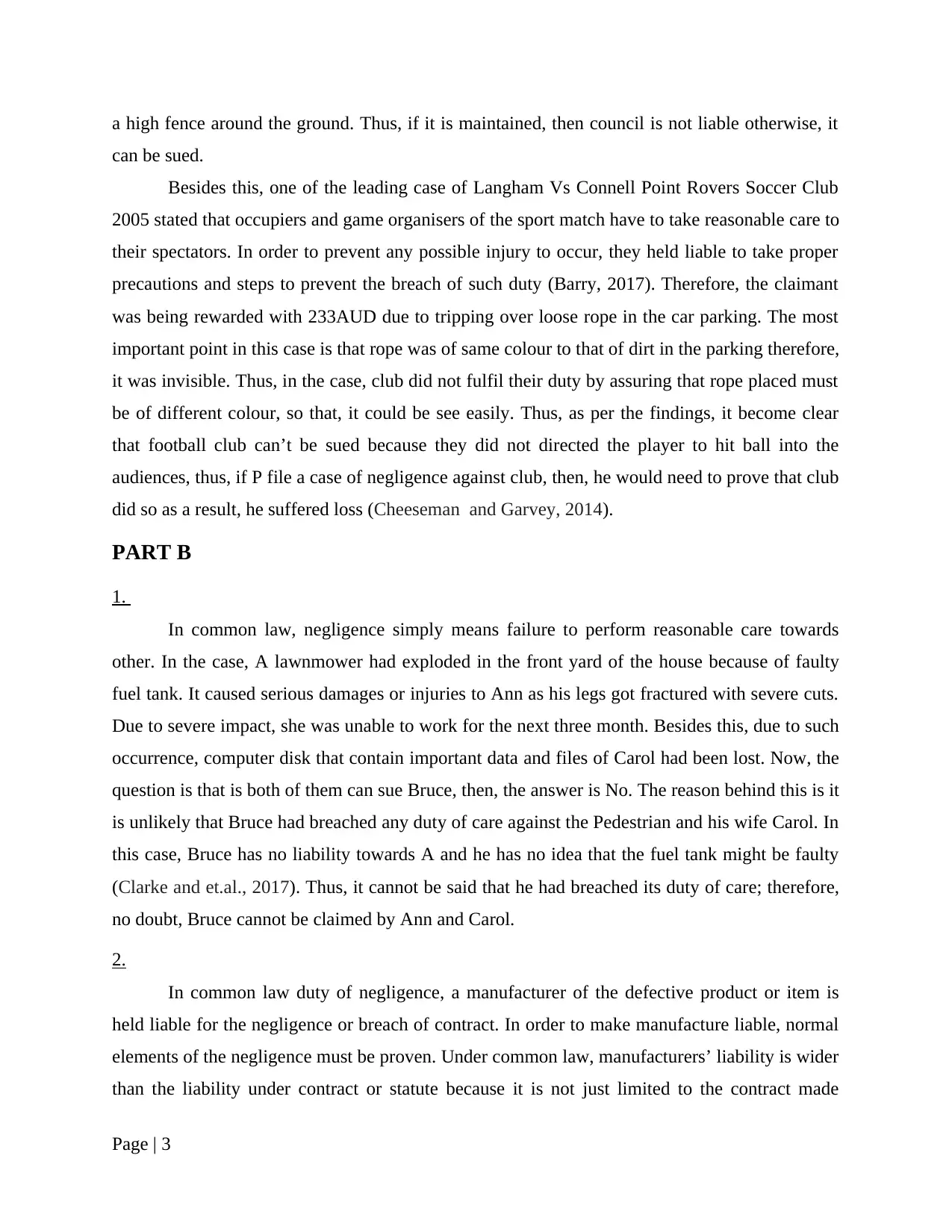
a high fence around the ground. Thus, if it is maintained, then council is not liable otherwise, it
can be sued.
Besides this, one of the leading case of Langham Vs Connell Point Rovers Soccer Club
2005 stated that occupiers and game organisers of the sport match have to take reasonable care to
their spectators. In order to prevent any possible injury to occur, they held liable to take proper
precautions and steps to prevent the breach of such duty (Barry, 2017). Therefore, the claimant
was being rewarded with 233AUD due to tripping over loose rope in the car parking. The most
important point in this case is that rope was of same colour to that of dirt in the parking therefore,
it was invisible. Thus, in the case, club did not fulfil their duty by assuring that rope placed must
be of different colour, so that, it could be see easily. Thus, as per the findings, it become clear
that football club can’t be sued because they did not directed the player to hit ball into the
audiences, thus, if P file a case of negligence against club, then, he would need to prove that club
did so as a result, he suffered loss (Cheeseman and Garvey, 2014).
PART B
1.
In common law, negligence simply means failure to perform reasonable care towards
other. In the case, A lawnmower had exploded in the front yard of the house because of faulty
fuel tank. It caused serious damages or injuries to Ann as his legs got fractured with severe cuts.
Due to severe impact, she was unable to work for the next three month. Besides this, due to such
occurrence, computer disk that contain important data and files of Carol had been lost. Now, the
question is that is both of them can sue Bruce, then, the answer is No. The reason behind this is it
is unlikely that Bruce had breached any duty of care against the Pedestrian and his wife Carol. In
this case, Bruce has no liability towards A and he has no idea that the fuel tank might be faulty
(Clarke and et.al., 2017). Thus, it cannot be said that he had breached its duty of care; therefore,
no doubt, Bruce cannot be claimed by Ann and Carol.
2.
In common law duty of negligence, a manufacturer of the defective product or item is
held liable for the negligence or breach of contract. In order to make manufacture liable, normal
elements of the negligence must be proven. Under common law, manufacturers’ liability is wider
than the liability under contract or statute because it is not just limited to the contract made
Page | 3
can be sued.
Besides this, one of the leading case of Langham Vs Connell Point Rovers Soccer Club
2005 stated that occupiers and game organisers of the sport match have to take reasonable care to
their spectators. In order to prevent any possible injury to occur, they held liable to take proper
precautions and steps to prevent the breach of such duty (Barry, 2017). Therefore, the claimant
was being rewarded with 233AUD due to tripping over loose rope in the car parking. The most
important point in this case is that rope was of same colour to that of dirt in the parking therefore,
it was invisible. Thus, in the case, club did not fulfil their duty by assuring that rope placed must
be of different colour, so that, it could be see easily. Thus, as per the findings, it become clear
that football club can’t be sued because they did not directed the player to hit ball into the
audiences, thus, if P file a case of negligence against club, then, he would need to prove that club
did so as a result, he suffered loss (Cheeseman and Garvey, 2014).
PART B
1.
In common law, negligence simply means failure to perform reasonable care towards
other. In the case, A lawnmower had exploded in the front yard of the house because of faulty
fuel tank. It caused serious damages or injuries to Ann as his legs got fractured with severe cuts.
Due to severe impact, she was unable to work for the next three month. Besides this, due to such
occurrence, computer disk that contain important data and files of Carol had been lost. Now, the
question is that is both of them can sue Bruce, then, the answer is No. The reason behind this is it
is unlikely that Bruce had breached any duty of care against the Pedestrian and his wife Carol. In
this case, Bruce has no liability towards A and he has no idea that the fuel tank might be faulty
(Clarke and et.al., 2017). Thus, it cannot be said that he had breached its duty of care; therefore,
no doubt, Bruce cannot be claimed by Ann and Carol.
2.
In common law duty of negligence, a manufacturer of the defective product or item is
held liable for the negligence or breach of contract. In order to make manufacture liable, normal
elements of the negligence must be proven. Under common law, manufacturers’ liability is wider
than the liability under contract or statute because it is not just limited to the contract made
Page | 3
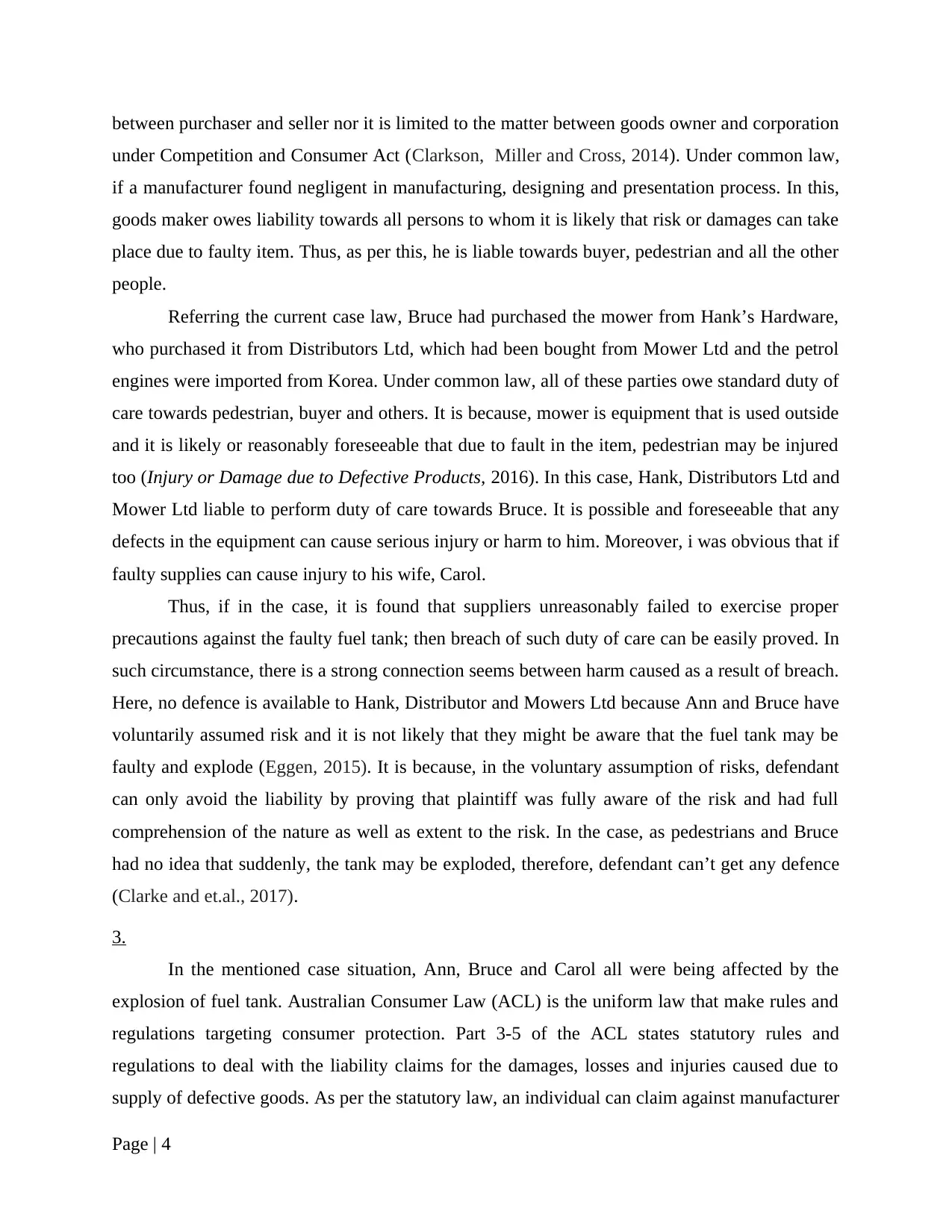
between purchaser and seller nor it is limited to the matter between goods owner and corporation
under Competition and Consumer Act (Clarkson, Miller and Cross, 2014). Under common law,
if a manufacturer found negligent in manufacturing, designing and presentation process. In this,
goods maker owes liability towards all persons to whom it is likely that risk or damages can take
place due to faulty item. Thus, as per this, he is liable towards buyer, pedestrian and all the other
people.
Referring the current case law, Bruce had purchased the mower from Hank’s Hardware,
who purchased it from Distributors Ltd, which had been bought from Mower Ltd and the petrol
engines were imported from Korea. Under common law, all of these parties owe standard duty of
care towards pedestrian, buyer and others. It is because, mower is equipment that is used outside
and it is likely or reasonably foreseeable that due to fault in the item, pedestrian may be injured
too (Injury or Damage due to Defective Products, 2016). In this case, Hank, Distributors Ltd and
Mower Ltd liable to perform duty of care towards Bruce. It is possible and foreseeable that any
defects in the equipment can cause serious injury or harm to him. Moreover, i was obvious that if
faulty supplies can cause injury to his wife, Carol.
Thus, if in the case, it is found that suppliers unreasonably failed to exercise proper
precautions against the faulty fuel tank; then breach of such duty of care can be easily proved. In
such circumstance, there is a strong connection seems between harm caused as a result of breach.
Here, no defence is available to Hank, Distributor and Mowers Ltd because Ann and Bruce have
voluntarily assumed risk and it is not likely that they might be aware that the fuel tank may be
faulty and explode (Eggen, 2015). It is because, in the voluntary assumption of risks, defendant
can only avoid the liability by proving that plaintiff was fully aware of the risk and had full
comprehension of the nature as well as extent to the risk. In the case, as pedestrians and Bruce
had no idea that suddenly, the tank may be exploded, therefore, defendant can’t get any defence
(Clarke and et.al., 2017).
3.
In the mentioned case situation, Ann, Bruce and Carol all were being affected by the
explosion of fuel tank. Australian Consumer Law (ACL) is the uniform law that make rules and
regulations targeting consumer protection. Part 3-5 of the ACL states statutory rules and
regulations to deal with the liability claims for the damages, losses and injuries caused due to
supply of defective goods. As per the statutory law, an individual can claim against manufacturer
Page | 4
under Competition and Consumer Act (Clarkson, Miller and Cross, 2014). Under common law,
if a manufacturer found negligent in manufacturing, designing and presentation process. In this,
goods maker owes liability towards all persons to whom it is likely that risk or damages can take
place due to faulty item. Thus, as per this, he is liable towards buyer, pedestrian and all the other
people.
Referring the current case law, Bruce had purchased the mower from Hank’s Hardware,
who purchased it from Distributors Ltd, which had been bought from Mower Ltd and the petrol
engines were imported from Korea. Under common law, all of these parties owe standard duty of
care towards pedestrian, buyer and others. It is because, mower is equipment that is used outside
and it is likely or reasonably foreseeable that due to fault in the item, pedestrian may be injured
too (Injury or Damage due to Defective Products, 2016). In this case, Hank, Distributors Ltd and
Mower Ltd liable to perform duty of care towards Bruce. It is possible and foreseeable that any
defects in the equipment can cause serious injury or harm to him. Moreover, i was obvious that if
faulty supplies can cause injury to his wife, Carol.
Thus, if in the case, it is found that suppliers unreasonably failed to exercise proper
precautions against the faulty fuel tank; then breach of such duty of care can be easily proved. In
such circumstance, there is a strong connection seems between harm caused as a result of breach.
Here, no defence is available to Hank, Distributor and Mowers Ltd because Ann and Bruce have
voluntarily assumed risk and it is not likely that they might be aware that the fuel tank may be
faulty and explode (Eggen, 2015). It is because, in the voluntary assumption of risks, defendant
can only avoid the liability by proving that plaintiff was fully aware of the risk and had full
comprehension of the nature as well as extent to the risk. In the case, as pedestrians and Bruce
had no idea that suddenly, the tank may be exploded, therefore, defendant can’t get any defence
(Clarke and et.al., 2017).
3.
In the mentioned case situation, Ann, Bruce and Carol all were being affected by the
explosion of fuel tank. Australian Consumer Law (ACL) is the uniform law that make rules and
regulations targeting consumer protection. Part 3-5 of the ACL states statutory rules and
regulations to deal with the liability claims for the damages, losses and injuries caused due to
supply of defective goods. As per the statutory law, an individual can claim against manufacturer
Page | 4
⊘ This is a preview!⊘
Do you want full access?
Subscribe today to unlock all pages.

Trusted by 1+ million students worldwide
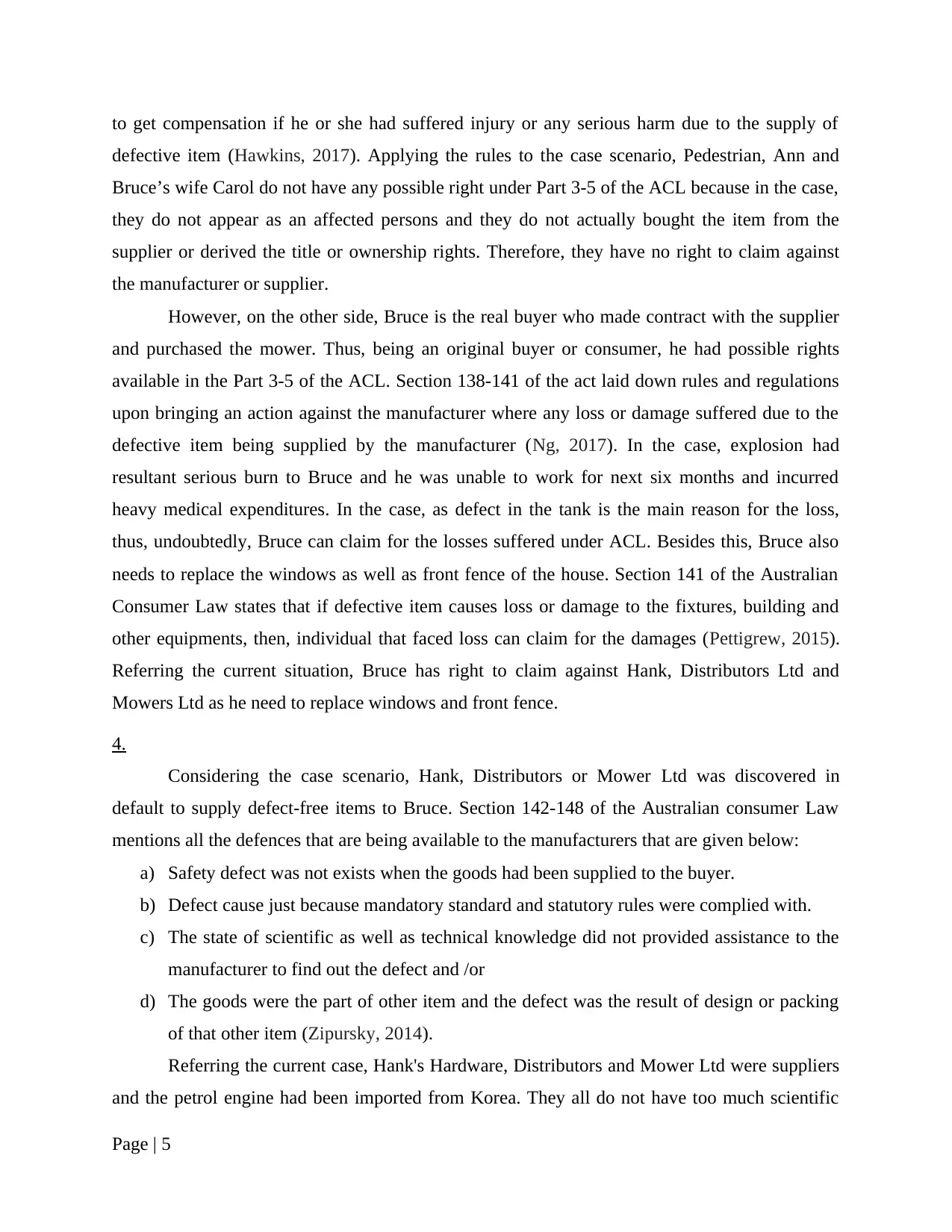
to get compensation if he or she had suffered injury or any serious harm due to the supply of
defective item (Hawkins, 2017). Applying the rules to the case scenario, Pedestrian, Ann and
Bruce’s wife Carol do not have any possible right under Part 3-5 of the ACL because in the case,
they do not appear as an affected persons and they do not actually bought the item from the
supplier or derived the title or ownership rights. Therefore, they have no right to claim against
the manufacturer or supplier.
However, on the other side, Bruce is the real buyer who made contract with the supplier
and purchased the mower. Thus, being an original buyer or consumer, he had possible rights
available in the Part 3-5 of the ACL. Section 138-141 of the act laid down rules and regulations
upon bringing an action against the manufacturer where any loss or damage suffered due to the
defective item being supplied by the manufacturer (Ng, 2017). In the case, explosion had
resultant serious burn to Bruce and he was unable to work for next six months and incurred
heavy medical expenditures. In the case, as defect in the tank is the main reason for the loss,
thus, undoubtedly, Bruce can claim for the losses suffered under ACL. Besides this, Bruce also
needs to replace the windows as well as front fence of the house. Section 141 of the Australian
Consumer Law states that if defective item causes loss or damage to the fixtures, building and
other equipments, then, individual that faced loss can claim for the damages (Pettigrew, 2015).
Referring the current situation, Bruce has right to claim against Hank, Distributors Ltd and
Mowers Ltd as he need to replace windows and front fence.
4.
Considering the case scenario, Hank, Distributors or Mower Ltd was discovered in
default to supply defect-free items to Bruce. Section 142-148 of the Australian consumer Law
mentions all the defences that are being available to the manufacturers that are given below:
a) Safety defect was not exists when the goods had been supplied to the buyer.
b) Defect cause just because mandatory standard and statutory rules were complied with.
c) The state of scientific as well as technical knowledge did not provided assistance to the
manufacturer to find out the defect and /or
d) The goods were the part of other item and the defect was the result of design or packing
of that other item (Zipursky, 2014).
Referring the current case, Hank's Hardware, Distributors and Mower Ltd were suppliers
and the petrol engine had been imported from Korea. They all do not have too much scientific
Page | 5
defective item (Hawkins, 2017). Applying the rules to the case scenario, Pedestrian, Ann and
Bruce’s wife Carol do not have any possible right under Part 3-5 of the ACL because in the case,
they do not appear as an affected persons and they do not actually bought the item from the
supplier or derived the title or ownership rights. Therefore, they have no right to claim against
the manufacturer or supplier.
However, on the other side, Bruce is the real buyer who made contract with the supplier
and purchased the mower. Thus, being an original buyer or consumer, he had possible rights
available in the Part 3-5 of the ACL. Section 138-141 of the act laid down rules and regulations
upon bringing an action against the manufacturer where any loss or damage suffered due to the
defective item being supplied by the manufacturer (Ng, 2017). In the case, explosion had
resultant serious burn to Bruce and he was unable to work for next six months and incurred
heavy medical expenditures. In the case, as defect in the tank is the main reason for the loss,
thus, undoubtedly, Bruce can claim for the losses suffered under ACL. Besides this, Bruce also
needs to replace the windows as well as front fence of the house. Section 141 of the Australian
Consumer Law states that if defective item causes loss or damage to the fixtures, building and
other equipments, then, individual that faced loss can claim for the damages (Pettigrew, 2015).
Referring the current situation, Bruce has right to claim against Hank, Distributors Ltd and
Mowers Ltd as he need to replace windows and front fence.
4.
Considering the case scenario, Hank, Distributors or Mower Ltd was discovered in
default to supply defect-free items to Bruce. Section 142-148 of the Australian consumer Law
mentions all the defences that are being available to the manufacturers that are given below:
a) Safety defect was not exists when the goods had been supplied to the buyer.
b) Defect cause just because mandatory standard and statutory rules were complied with.
c) The state of scientific as well as technical knowledge did not provided assistance to the
manufacturer to find out the defect and /or
d) The goods were the part of other item and the defect was the result of design or packing
of that other item (Zipursky, 2014).
Referring the current case, Hank's Hardware, Distributors and Mower Ltd were suppliers
and the petrol engine had been imported from Korea. They all do not have too much scientific
Page | 5
Paraphrase This Document
Need a fresh take? Get an instant paraphrase of this document with our AI Paraphraser
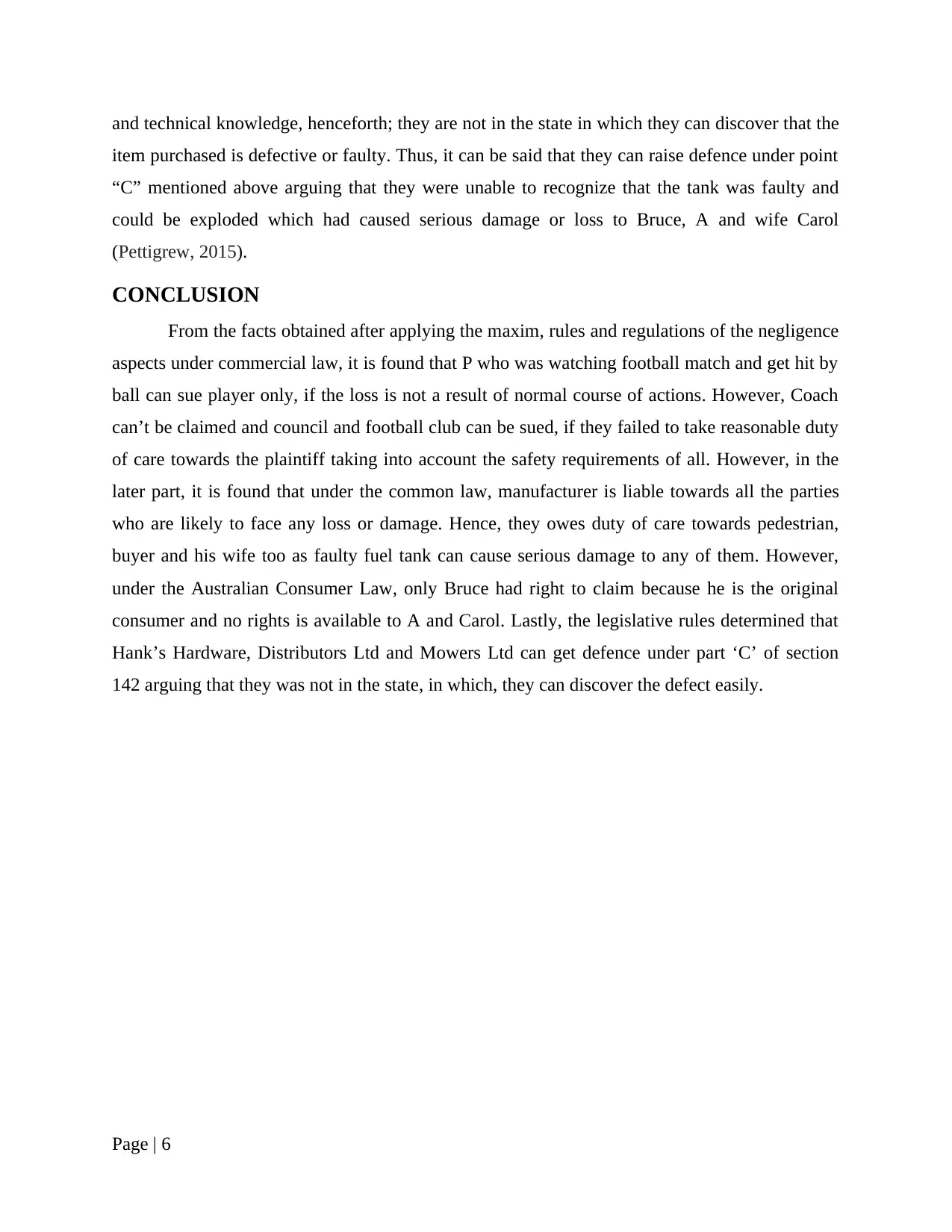
and technical knowledge, henceforth; they are not in the state in which they can discover that the
item purchased is defective or faulty. Thus, it can be said that they can raise defence under point
“C” mentioned above arguing that they were unable to recognize that the tank was faulty and
could be exploded which had caused serious damage or loss to Bruce, A and wife Carol
(Pettigrew, 2015).
CONCLUSION
From the facts obtained after applying the maxim, rules and regulations of the negligence
aspects under commercial law, it is found that P who was watching football match and get hit by
ball can sue player only, if the loss is not a result of normal course of actions. However, Coach
can’t be claimed and council and football club can be sued, if they failed to take reasonable duty
of care towards the plaintiff taking into account the safety requirements of all. However, in the
later part, it is found that under the common law, manufacturer is liable towards all the parties
who are likely to face any loss or damage. Hence, they owes duty of care towards pedestrian,
buyer and his wife too as faulty fuel tank can cause serious damage to any of them. However,
under the Australian Consumer Law, only Bruce had right to claim because he is the original
consumer and no rights is available to A and Carol. Lastly, the legislative rules determined that
Hank’s Hardware, Distributors Ltd and Mowers Ltd can get defence under part ‘C’ of section
142 arguing that they was not in the state, in which, they can discover the defect easily.
Page | 6
item purchased is defective or faulty. Thus, it can be said that they can raise defence under point
“C” mentioned above arguing that they were unable to recognize that the tank was faulty and
could be exploded which had caused serious damage or loss to Bruce, A and wife Carol
(Pettigrew, 2015).
CONCLUSION
From the facts obtained after applying the maxim, rules and regulations of the negligence
aspects under commercial law, it is found that P who was watching football match and get hit by
ball can sue player only, if the loss is not a result of normal course of actions. However, Coach
can’t be claimed and council and football club can be sued, if they failed to take reasonable duty
of care towards the plaintiff taking into account the safety requirements of all. However, in the
later part, it is found that under the common law, manufacturer is liable towards all the parties
who are likely to face any loss or damage. Hence, they owes duty of care towards pedestrian,
buyer and his wife too as faulty fuel tank can cause serious damage to any of them. However,
under the Australian Consumer Law, only Bruce had right to claim because he is the original
consumer and no rights is available to A and Carol. Lastly, the legislative rules determined that
Hank’s Hardware, Distributors Ltd and Mowers Ltd can get defence under part ‘C’ of section
142 arguing that they was not in the state, in which, they can discover the defect easily.
Page | 6
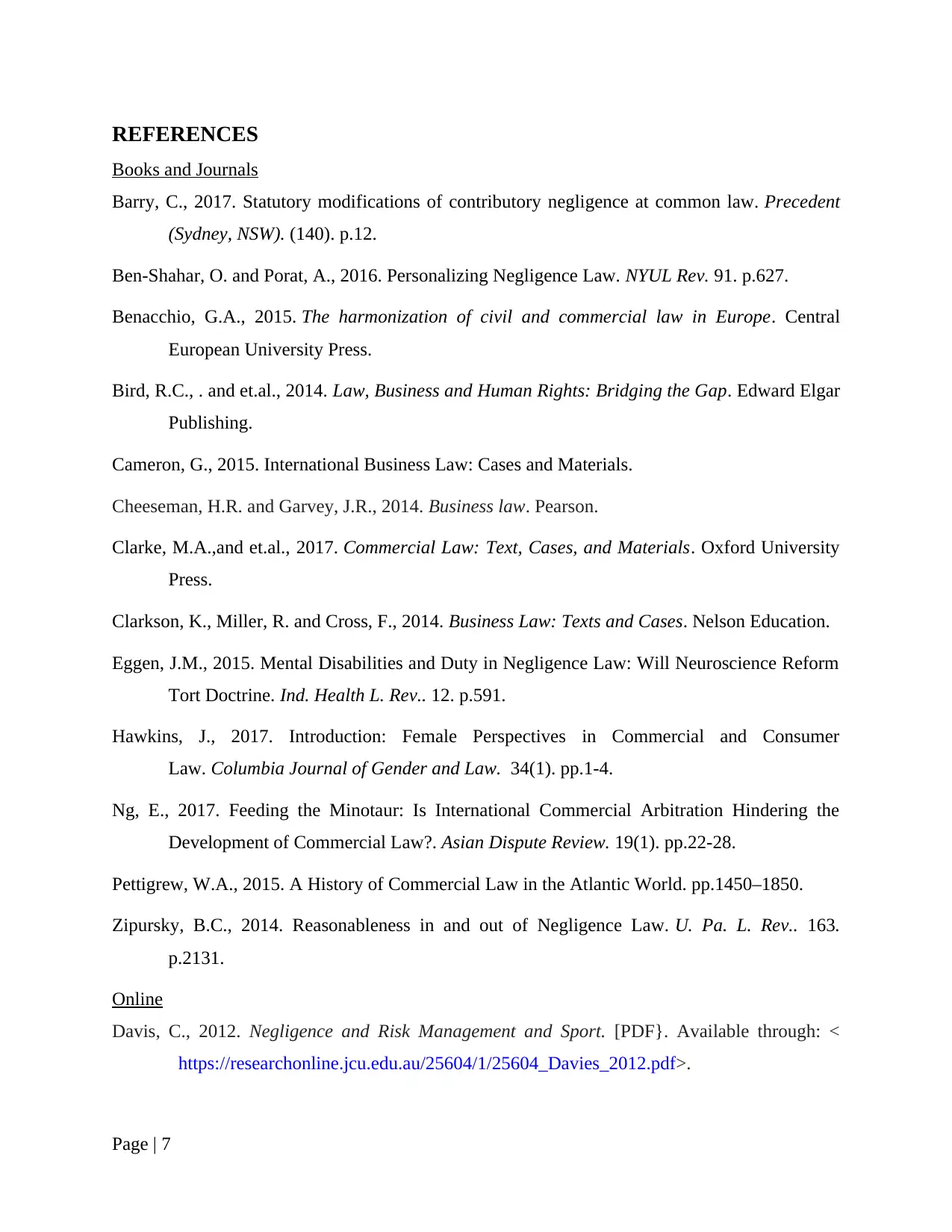
REFERENCES
Books and Journals
Barry, C., 2017. Statutory modifications of contributory negligence at common law. Precedent
(Sydney, NSW). (140). p.12.
Ben-Shahar, O. and Porat, A., 2016. Personalizing Negligence Law. NYUL Rev. 91. p.627.
Benacchio, G.A., 2015. The harmonization of civil and commercial law in Europe. Central
European University Press.
Bird, R.C., . and et.al., 2014. Law, Business and Human Rights: Bridging the Gap. Edward Elgar
Publishing.
Cameron, G., 2015. International Business Law: Cases and Materials.
Cheeseman, H.R. and Garvey, J.R., 2014. Business law. Pearson.
Clarke, M.A.,and et.al., 2017. Commercial Law: Text, Cases, and Materials. Oxford University
Press.
Clarkson, K., Miller, R. and Cross, F., 2014. Business Law: Texts and Cases. Nelson Education.
Eggen, J.M., 2015. Mental Disabilities and Duty in Negligence Law: Will Neuroscience Reform
Tort Doctrine. Ind. Health L. Rev.. 12. p.591.
Hawkins, J., 2017. Introduction: Female Perspectives in Commercial and Consumer
Law. Columbia Journal of Gender and Law. 34(1). pp.1-4.
Ng, E., 2017. Feeding the Minotaur: Is International Commercial Arbitration Hindering the
Development of Commercial Law?. Asian Dispute Review. 19(1). pp.22-28.
Pettigrew, W.A., 2015. A History of Commercial Law in the Atlantic World. pp.1450–1850.
Zipursky, B.C., 2014. Reasonableness in and out of Negligence Law. U. Pa. L. Rev.. 163.
p.2131.
Online
Davis, C., 2012. Negligence and Risk Management and Sport. [PDF}. Available through: <
https://researchonline.jcu.edu.au/25604/1/25604_Davies_2012.pdf>.
Page | 7
Books and Journals
Barry, C., 2017. Statutory modifications of contributory negligence at common law. Precedent
(Sydney, NSW). (140). p.12.
Ben-Shahar, O. and Porat, A., 2016. Personalizing Negligence Law. NYUL Rev. 91. p.627.
Benacchio, G.A., 2015. The harmonization of civil and commercial law in Europe. Central
European University Press.
Bird, R.C., . and et.al., 2014. Law, Business and Human Rights: Bridging the Gap. Edward Elgar
Publishing.
Cameron, G., 2015. International Business Law: Cases and Materials.
Cheeseman, H.R. and Garvey, J.R., 2014. Business law. Pearson.
Clarke, M.A.,and et.al., 2017. Commercial Law: Text, Cases, and Materials. Oxford University
Press.
Clarkson, K., Miller, R. and Cross, F., 2014. Business Law: Texts and Cases. Nelson Education.
Eggen, J.M., 2015. Mental Disabilities and Duty in Negligence Law: Will Neuroscience Reform
Tort Doctrine. Ind. Health L. Rev.. 12. p.591.
Hawkins, J., 2017. Introduction: Female Perspectives in Commercial and Consumer
Law. Columbia Journal of Gender and Law. 34(1). pp.1-4.
Ng, E., 2017. Feeding the Minotaur: Is International Commercial Arbitration Hindering the
Development of Commercial Law?. Asian Dispute Review. 19(1). pp.22-28.
Pettigrew, W.A., 2015. A History of Commercial Law in the Atlantic World. pp.1450–1850.
Zipursky, B.C., 2014. Reasonableness in and out of Negligence Law. U. Pa. L. Rev.. 163.
p.2131.
Online
Davis, C., 2012. Negligence and Risk Management and Sport. [PDF}. Available through: <
https://researchonline.jcu.edu.au/25604/1/25604_Davies_2012.pdf>.
Page | 7
⊘ This is a preview!⊘
Do you want full access?
Subscribe today to unlock all pages.

Trusted by 1+ million students worldwide
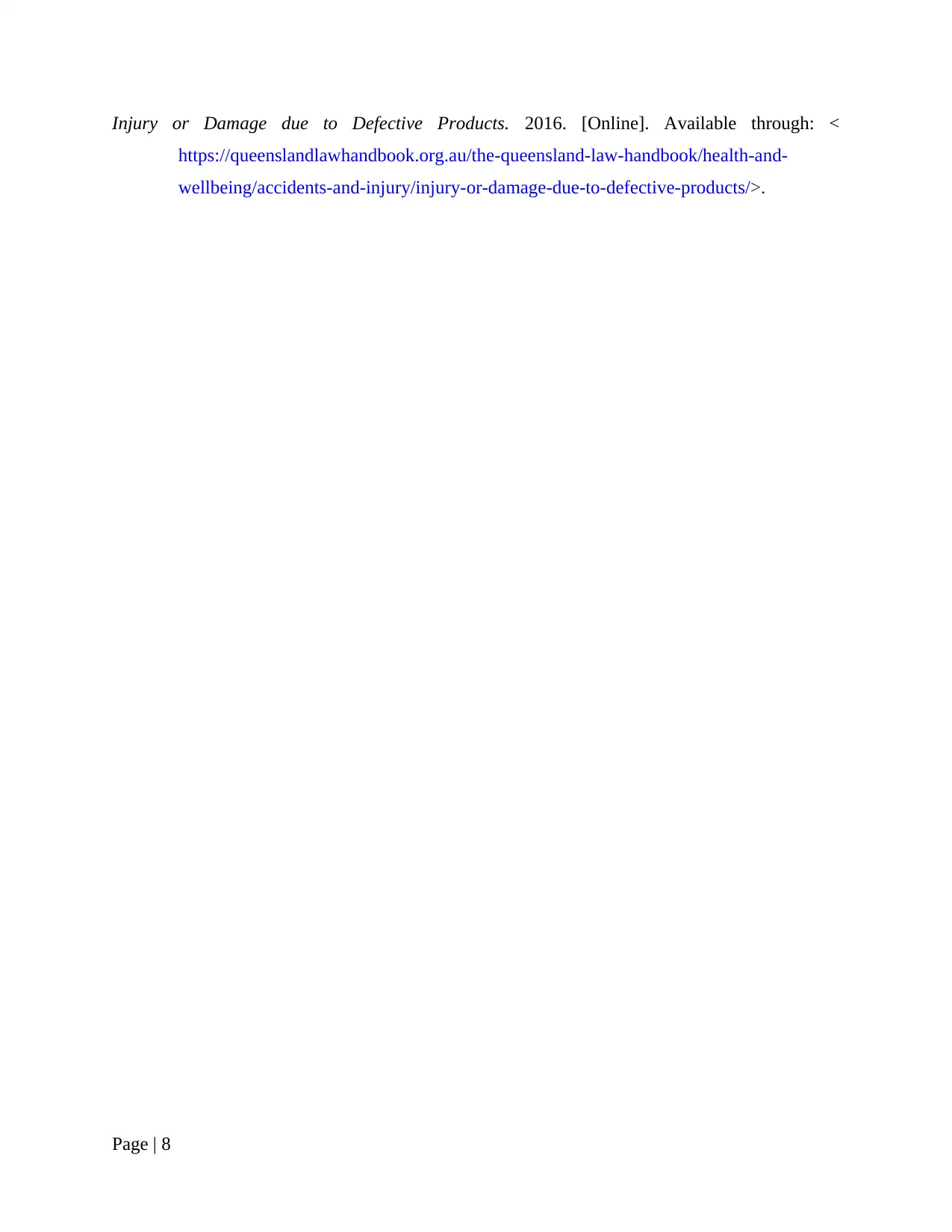
Injury or Damage due to Defective Products. 2016. [Online]. Available through: <
https://queenslandlawhandbook.org.au/the-queensland-law-handbook/health-and-
wellbeing/accidents-and-injury/injury-or-damage-due-to-defective-products/>.
Page | 8
https://queenslandlawhandbook.org.au/the-queensland-law-handbook/health-and-
wellbeing/accidents-and-injury/injury-or-damage-due-to-defective-products/>.
Page | 8
1 out of 10
Related Documents
Your All-in-One AI-Powered Toolkit for Academic Success.
+13062052269
info@desklib.com
Available 24*7 on WhatsApp / Email
![[object Object]](/_next/static/media/star-bottom.7253800d.svg)
Unlock your academic potential
Copyright © 2020–2025 A2Z Services. All Rights Reserved. Developed and managed by ZUCOL.





